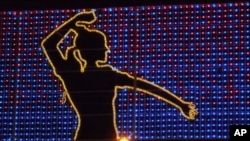The southern Spanish city of Malaga is in the midst of its biggest celebration of the year - the "Feria" -- a nine day party that goes from the 13th to the 22nd of August and celebrates the Christian re-conquest of the city from its Arab rulers in 1487. It is Spain's biggest party with more than six million people dancing and drinking in the streets. It begins with a procession of horse-drawn carriages and men and women on horseback.
The Feria begins with a procession called the Romeria which starts at the City Hall. The women wear long tight-fitting dresses with ruffled hems. Some wear high Spanish combs draped with lace. The younger women prefer brightly colored plastic combs and flowers that match their dresses.
More than a hundred carriages decked out with flowers, red and yellow pom poms and bells roll through streets of the city center. They are joined by more than 70 beautiful horses ridden by men and women wearing Andalusian garb.
It's only a few kilometers to the church of Santa Victoria, where everyone gives thanks for the fifteenth century Christian victory over the Muslims who ruled Andalusia more than 600 years ago. Julian Sandez, of the Malaga city council, says the statue of Santa Maria Victoria was a gift from Queen Isabella and King Ferdinand in the 15th century.
"The origin is because Malaga was taken by the Christians on 19th of August. We have first day a parade in honor of our lady of Victory. Feria means for us drink, dance and be with people. If you want you can have 20 hours of Feria every day."
And that's exactly what many people do. Stores and businesses close down for three days and everybody parties. The bullfight is still very popular in Malaga and more than 9,000 people crowd into the bullring for bullfights that take place almost every night during the Feria.
At the Real de la Feria just outside the city 600,000 colored lights turn night into day. People start filling the 150 casetas or pavilions at 9 pm and the party lasts all night. More than 6 million people come the Real de la Feria to eat tapas, drink dry sherry called fino and dance the night away.
"My name is Samantha Friederich. I like the music the flamenco dresses, the horses, the wine and Jamon Serano, the ham…We have two areas. Here is the traditional area with traditional casetas, flamenco and dancing. The other area is for young people with discos and they drink alcohol, not wine."
For Malaga the Feria is a time to set aside problems and differences and enjoy the music, the fino and the fun until the festival ends on August 22.




